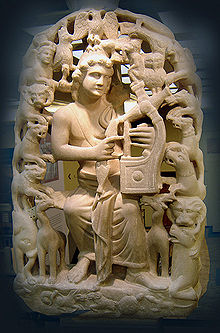Neobyzantine Octoechos
| Music of Turkey | |
|---|---|
| General topics | |
| Genres | |
| Specific forms | |
| Ethnic music | |
| Turkish marches | |
| Media and performance | |
| Music awards | |
| Music charts | |
| Music festivals | |
| Music media | |
| Nationalistic and patriotic songs | |
| National anthem | Independence March |
| Regional music | |
| Music of Greece | |
|---|---|
 |
|
| General topics | |
| Genres | |
| Specific forms | |
| Media and performance | |
| Music awards |
|
| Music charts | |
| Music festivals | |
| Music media |
|
| Nationalistic and patriotic songs | |
| National anthem | "Hymn to Liberty" |
| Regional music | |
| Related areas | Cyprus, Pontus, Constantinople, South Italy |
| Regional styles |
|
Oktōēchos (here transcribed "Octoechos"; Greek: ὁ Ὀκτώηχος Greek pronunciation: [okˈtóixos]; from "eight" and "sound, mode" called echos; Slavonic: Осмогласие, Osmoglasie from "eight" and "voice, sound") is the name of the eight mode system used for the composition of religious chant in Byzantine, Syriac, Armenian, Georgian, Latin and Slavic churches since the Middle Ages. In a modified form the octoechos is still regarded as the foundation of the tradition of monodic Orthodox chant today.
From a Phanariot point of view, the re-formulation of the Octoechos and its melodic models according to the New Method was neither a simplification of the Byzantine tradition nor an adaption to Western tonality and its method of an heptaphonic solfeggio, just based on one tone system (σύστημα κατὰ ἑπταφωνίαν). Quite the opposite, as a universal approach to music traditions of the Mediterranean it was rather based on the integrative power of the psaltic art and the Papadike, which can be traced back to the Hagiopolitan Octoechos and its exchange with Oriental music traditions since more than thousand years.
Hence, the current article is divided into three parts. The first is a discussion of the current solfeggio method based on seven syllables in combination with the invention of a universal notation system which transcribed the melos in the very detail (Chrysanthos' Theoretikon mega). The second and third part are based on a theoretical separation between the exoteric and the esoteric use of modern or Neobyzantine notation. Exoteric (ἐξωτερική = "External") music meant the transcription of patriotic songs, opera arias, traditional music of the Mediterrean including Ottoman makam and Persian music, while esoteric (ἐσωτερική = "internal") pointed at the papadic tradition of using Round notation with the modal signatures of the eight modes, now interpreted as a simple pitch key without implying any cadential patterns of a certain echos. In practice there had never been such a rigid separation between exoteric and esoteric among Romaic musicians, certain exchanges—with makam traditions in particular—were rather essential for the redefinition of Byzantine Chant, at least according to the traditional chant books published as "internal music" by the teachers of the New Music School of the Patriarchate.
...
Wikipedia
